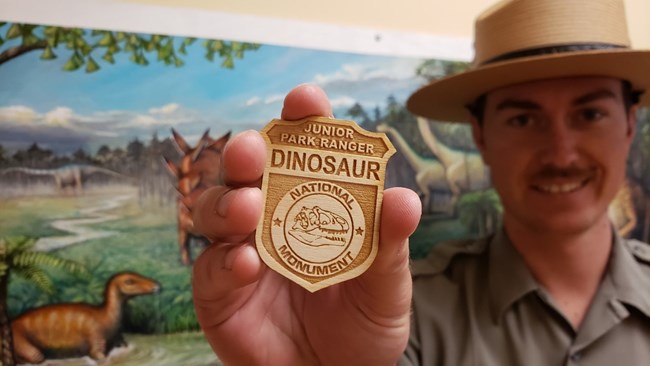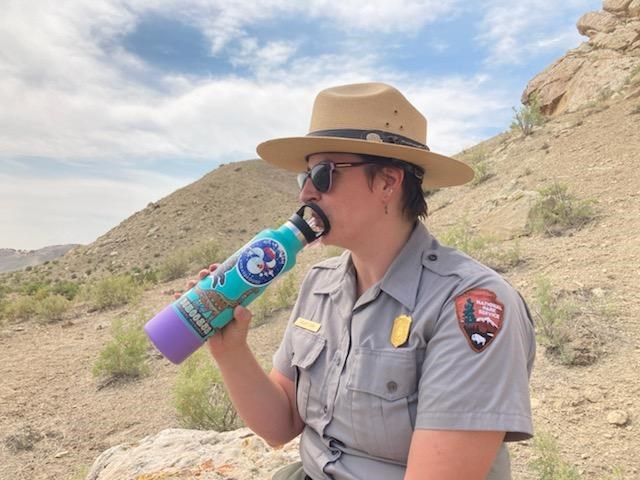Last updated: July 14, 2021
Article
Plan Like a Park Ranger - Top Tips For Visiting Dinosaur

Just remember to spell it out: D-I-N-O-S-A-U-R!

Drive Safely
We want you to arrive alive; please follow all posted speed limits and watch for animals crossing the road. Dinosaur National Monument has various wildlife and local grazing cattle on the roads that can be surprising during daylight hours and difficult to see in low light. When researching directions, check a physical map to confirm your route; while GPS is handy and convenient, it is often unreliable in many National Park Service sites and may send you on unpaved roads your car can’t handle. Be sure to check current road conditions, so you know your path is safe to travel.Like most parks, Dinosaur has multiple access point, but very few through roads. For example, if you are looking for the dinosaur fossils, you’ll need to plan a driving route that will take you to the Quarry Entrance near Jensen, Utah. If rugged canyon views are more your style, look for the Canyon Entrance near Dinosaur, Colorado.
Since there are no places to fill up with gas inside the monument, be sure to arrive with a full tank.

Inspire Others
While visiting Dinosaur National Monument, follow rules and guidelines to leave the monument better than when you found it. You can lead by example by sharing your excellent behavior on social media – including staying on the trail, not picking the flowers, not touching or adding any marks to petroglyphs, and leaving cool rocks or fossils in place. Kids of all ages can become a Junior Ranger to learn about what makes Dinosaur special and why we need to protect it. Earn your Junior Ranger badge and wear it with pride!
Nighttime Visits
Dinosaur National Monument is an International Dark Sky Park. The monument can be accessed 24 hours to allow for star gazing, even for visitors who are not staying in the campgrounds. Plan on bringing extra layers of clothing, snacks, and water, along with any star maps, star apps, or equipment you may want to use to enjoy the pristine night sky. Visit www.cleardarksky.com or www.timeanddate.com to check for optimal night sky viewing. Depending on which phase of the moon you are looking for, new and crescent moon phases are ideal nights for observing dark sky objects, lunar surface details, and the Milky Way during the summer and autumn. Cover your flashlights with red cellophane and try to park in a way that minimizes headlights shining on any other visitors or wildlife. Half to full moon nights are excellent for night hikes with the moon as your light source.
Options! Options! Options!
Be flexible. Sometimes unexpected things like car trouble, traffic, or weather can cause plans to change. Popular attractions like the Quarry Exhibit Hall or Josie Bassett’s Cabin can get busy between 10am to 2pm; so you may need to visit a quieter space to avoid crowds or full parking lots. If you are traveling with a group that has different levels of interest and abilities, pick activities that don’t rely on the entire group doing the exact same thing.
Snacks and Water
Pack extra snacks, water, hand sanitizer supplies, or items that may not be available when visiting. Some services may be over an hour away from sites within the monument. If you are planning to picnic like a ranger but not in a designated picnic site, look for places with rocks to sit on and shade to sit under, protecting you from the sun and minimizing your impact on plants. Pack healthy salty snacks to replenish salt loss from sweat, and healthy sweet snacks to look forward to on your hike. Remember to Pack Out what you Pack In, meaning to pack up all waste, even “natural” things like apple cores, orange peels, or sunflower shells. Hydration is important when recreating, and not all people enjoy the taste of plain tap water. Adding flavoring or fruit slices to water bottles can encourage non-water drinkers to stay hydrated. Dinosaur’s high elevation and dry summer weather can lead to headaches, heat related illnesses, or worse, if visitors forget to stay hydrated.
Ask the Experts
Be sure to check your sources when researching your upcoming trip. Official NPS websites like www.nps.gov/dino or each park’s Facebook page will give you the most up-to-date information on visiting Dinosaur versus third party sites. You can download the NPS App for information on the go and select ”save this park for offline use” for when you’re out of cellular service. Be prepared for changing weather conditions by checking www.weather.gov to know if you need to pack extra sunscreen or an extra layer.
Unplug
While in the midst of planning hikes, excursions, and the next leg of your adventure, remember to plan for some downtime to relax and reflect. Consider adding an extra day or even just a few more hours to enjoy this time with yourself, your partner, or your family. Take time to sit and breathe and notice the sounds, smells, and sights around you that are different than what you normally experience at home. Jot down some notes while you are in the place itself, either on a postcard, a journal, or the memory recording devise of your choice. There is no such thing as being able to see it all, so don’t stress yourself out trying.
Recreate Responsibly
Whether seeking wide-open spaces or exploring a historic urban neighborhood, remember to Recreate Responsibly. The National Park Service encourages you to follow the guidance from the Centers for Disease Control and Prevention (CDC) to reduce the spread of COVID-19 and follow Leave No Trace principles when you visit park areas this summer:Know before you go. Visit the official park websites for current park conditions and availability of restrooms and other facilities. Make a plan, follow the 10 Essentials, and if you are sick, stay home.
Keep it close. Follow the state, tribal, and local orders for where you're traveling. The NPS is working closely with public health professionals to make operational changes and adapt to changing conditions.Keep your distance. Follow the CDC’s social distancing guidelines and stay at least six feet away from other people. Wear a mask when you are near others if you are not yet fully vaccinated —and always while riding public transportation.
Know your limits. Consider postponing challenging hikes or trying new activities while first responders, parks, and communities continue to concentrate on responding to the pandemic.
Keep it with you. If you brought it, take it with you. Trash pickup and restroom facilities will continue to be limited in many park areas.
Keep it inclusive. Be an active part of making our nation’s parks and public lands safe and welcoming for all identities and abilities.
